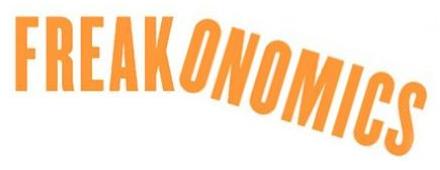A call for Freakonomics to clean up its act.

Earlier this week, I noticed a photo of cleavage on the Freakonomics blog. And I wondered. Where do these professional blogs get such high quality photos? Surely they are paying for them. Right?
“Freakonomics: A Rogue Economist Explores the Hidden Side of Everything” by Steven D. Levitt and Stephen J. Dubner.
Better Blogs With Photos
Conventional blogger wisdom says that adding photos to your blog posts is one way to increase readership.
Finding good photos to add can be challenging. If you are writing and commenting about a company, product, or famous person, then it’s a no-brainer that it’s fair use to use the company’s logo, product image, or headshot in your blog post. To make the case for fair use even stronger, you can even change the logo to make a point (as I did with broken Freakonomics logo for this article; see also my sad TiVo logo).
Copyright, Fair Use, And Google Images
But what if you’re writing about something more general? Like a new feature on your blog. Or the price of tea in China? Or golf? Or sushi? Can you just Google sushi and use the first image you find? Probably not. But many bloggers do it. I’ve probably done it. But I certainly try not to.
Regular readers of this blog have probably noticed some cheesy clipart that I’ve been adding to some blog posts (e.g. “new” graphic, penguin graphic, mailman graphic, “a genuine find” graphic, and coffee graphic). I do this when I can’t justify using a better image (i.e. one from Google Images) under the guise of fair use. Where did I get this clipart? I purchased it, paid for the rights to use it. And I’ve been trying to include graphics (photos, clip art, or the like) with each blog post since last November.
Freakonomics And The Cleavage Photo
So I decided to try to track down the origins of the cleavage photo. My search quickly got out of hand. In reverse chronological order, here’s where the photo has appeared:
- 2007-07-09 on Freakonomics.
- 2007-05-29 on eBaum’s World.
- 2006-07-17 on MySpace (via QuizFarm.com).
- 2006-03-14 on Crazy 8 Opinions.
- 2005-12-12. A Google search for xmike cleavage lead to Google Girls, which shows the face of the woman with the cleavage. Does she mind that her cleavage is being used to sell Freakonomics books? Is she getting a royalty on each book sold?
- 2005-11-22 on Coppermine (now 404).
- 2005-10-24. From the comments on Google Girls, there is a a link to a copy of the photo presumably taken from xMike.com (because it says “xmike.com” in the lower left corner of the uncropped photo).
- 2003-04-04. Which lead to this directory listing showing two files (cleavage.jpg and cleavage1.jpg) dated 2003-04-04.
- 2002-11-27 – 2003-03-30. Pages on the Internet Archive Wayback Machine from xMike.com that predate the earliest dated photo.
- 2003-03-30. Three of those four pages were “coming soon” pages, leaving one archive.org version of xMike.com.
Which lead to a dead end. And lots of pages on xMike.com that required an account. So I joined xMike.com. With the username Freakonomics. Which lead to another dead end. So that’s where my research on cleavage copyright ended. Maybe xMike.com or others can take it from here.
Freakonomics: History Of Borrowing Photos
Then I started looking more carefully at other photos on the Freakonomics blog. Where did those come from? Here’s a sampling of what I found.
On 05/04/07, Freakonomics welcomed a new editor, Melissa Lafsky. Shortly thereafter, I noticed that photos were included more regularly with blog posts. But that’s not all I noticed. (Open the links in new tabs or windows for comparison.)
05/04/07
- post: Vote Your Conscience
- image: vote
- vote – Google Image Search: 2nd result
- note: image is a direct link to http://www.nassaulibrary.org/bryant/blteens/uploaded_images/vote-748400.bmp (presumably from Client Service Insights)
05/04/07
- post: Phil Gordon’s Little Blue Book on Poker
- image: Phil Gordon
- Phil Gordon – Google image search: 7th result? (unknown because original image is 404)
- note: image is a direct link to http://mrpokerchips.com/store/images/PhilGordon.gif (and is now 404)
05/07/07
- post: Headlines from Pravda
- image: hammer and sickle
- hammer and sickle – Google image search: 1st, 2nd, and 3rd results
- note: image is a direct link to http://www.our-picks.com/wp-content/uploads/2006/12/200px-hammer_and_sickle.png
05/09/07
- post: A Gluttony Tax
- image: sushi
- sushi – Google image search: 9th result
05/10/07
- post: Levitt as Horse Bettor: Eh.
- image: horse racing
- horse racing – Google image search: not found
- note: image is a direct link to http://www.innovasporttours.com/racing.jpg (presumably from Innovate Sport Tours)
05/10/07
- post: Too Many Pesticides in the Water at the Indiana University School of Medicine?
- image: pesticides
- pesticides – Google image search: not found
- note: image is a direct link to http://www.veganpeace.com/organic/Pictures/pesticides.jpg (presumably from Vegan Peace)
05/15/07
- post: Your Input Needed: Hunting the Black Swan
- image: black swan
- black swan – Google image search: 7th result
- note: image is a direct link to http://www.bentley.org.uk/blackswan.jpg (presumably from Bentley Wildfowl & Motor Museum)
05/16/07
- post: If I Ask You About Doing Something, Will You Do It?
- image: brush teeth
- brush teeth – Google image search: 8th result
- note: image is a direct link to http://www.fivestarproductions.com/todayshealth/images/brush_teeth_lg.jpg (presumably from Today’s Health)
05/16/07
- post: Why Is There No All-Business-Class Jet Service Within the U.S.?
- image: business seat
- business seat – Google image search: 1st result
- note: image is a direct link to http://www.singaporeair.com/saa/en_UK/images/exp/eot/new/business_seat_1.jpg (presumably from Singapore Airlines)
05/23/07
- post: More Evidence of Cultural Bias in Testing
- image: tiara
- tiara – Google image search: not found
- note: image is a direct link to http://www.tiaratown.com/princessw1.jpg (presumably from Tiara Town)
05/30/07
- post: Kidney News You Won’t Believe
- image: kidney surgery
- kidney transplant – Google image search: not found
- note: image is a direct link to http://www.hinduonnet.com/fline/fl2009/images/20030509003009602.jpg (presumably from The Hindu)
06/11/07
- post: Another Economist Heard From in the Leisure/Work Debate
- image: housewife
- housewife – Google image search: 7th result
- note: image is presumably from AllPosters.com
This is just a sampling. There are many more examples of the Freakonomics blog linking directly to photos on other websites. And there are many more examples of photos apparently copied from other websites based on simple Google searches. This is no way to run a business blog.
Summary: For Discussion Only
Don’t get me wrong. I’m a big fan of Freakonomics. Steven Levitt’s research for the Freakonomics book was supported in part by the American Bar Foundation (ABF), and I’m an ABA fellow (you might say a fellow ABA fellow). The Freakonomics book is great, and you should buy it. The Freakonomics website is great, and you should read it. The Freakonomics blog probably drives sales of the book. I’m guessing they are not losing money by publishing the blog. It would be ironic for blog about economics not to understand the economics of blogging.
But my main points are as follows:
- Blog posts with photos are better than those without photos.
- It’s difficult for bloggers to figure our which photos are OK.
- If you’re writing about a organization, product, or public figure, then using a corresponding image of the organization, product, or public person is probably fair use. Otherwise, you use might be fair use, and it might not be fair use. This is not legal advice. Just one blogger’s opinion.
- Just because courts have said that Google’s use of thumbnail photos in its Google Images search engine is fair use doesn’t mean that every use of those thumbnail (or full-size) images found via Google Images is fair use.
- Directly linking to images on other website is not nice. This practice goes by many names, including inline linking, hotlinking, leeching, direct linking, and bandwidth theft.
- The Freakonomics team should publicly identify all blog posts where it directly linked to photos on third party websites, eliminate those direct links, publicly apologize to the third party website owners, and purchase some images for its blog.
I have no agenda. I’m a patent and trademark attorney who makes zero dollars from copyright law. I do want to point out a bad blogging practice by an otherwise great blog. And to encourage people to think a little bit more before assuming that your use of images culled from the Internet is fair use. Especially with pictures of people. Truth be told, I have been wondering for a long time where sites like Freakonomics and Lifehacker get such great images for their blogs. Because I’d like to find better images for my blog.
The Freakonomics post with the cleavage photo certainly got my attention. I think that was the point. But that post is potentially the most troubling. What price has been paid for getting the reader’s attention in this case? What if the woman in the photo never wanted her photo to be uploaded to the Internet in the first place? What if she’s a minor? Now her cleavage is being used to sell books. That’s not just wrong from a copyright perspective, it’s wrong from a privacy perspective. It’s wrong morally. It’s just plain wrong.

